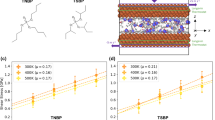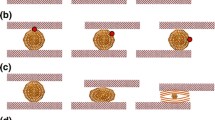Abstract
In the effort to reduce the energy consumption due to friction, finding new effective lubricants is of primary importance. Here we suggest selenium as a possible element for a highly effective lubricant on iron/iron interfaces by means of density functional theory. The adsorption properties of Se on the most stable iron surface are studied and the metal–adsorbate interaction is characterized. The adsorption reveals that selenium behaves similarly to sulfur and phosphorus, two key elements for high-pressure, anti-wear lubricant additives. The tribological properties of the Fe–Se/Se–Fe interface and the electronic modifications induced by the additive are then investigated and compared with Fe–P/P–Fe and Fe–S/S–Fe interfaces. The charge rearrangement at the interface and the density of states reveal the formation of strong covalent interactions inside the adsorbed layer of selenium atoms that weaken the metal–metal interaction. The calculated work of adhesion and ideal interfacial shear strength show that, with respect to P and S, Se possesses superior lubricating properties.







Similar content being viewed by others
Notes
The values slightly larger but consistent with previous findings in literature [16]. This is probably due to the different number of iron layers here considered in the iron slabs, 5 against 3, and to the higher number of high symmetry points used here for interpolating the PES’s: we consider also the three-fold and the intermediate points, that allow us to provide a more accurate evaluation of the PES and of the MEP.
References
Holmberg, K., Erdemir, A.: Global impact of friction on energy consumption, economy and environment. Fme Trans 43(3), 181–5 (2015)
Holmberg, K., Erdemir, A.: Influence of tribology on global energy consumption, costs and emissions. Friction 5(3), 263–284 (2017)
Binnig, G., Quate, C.F., Gerber, Ch.: Atomic force microscope. Phys. Rev. Lett. 56, 930–933 (1986)
Sarid, D., Elings, V.: Review of scanning force microscopy. J. Vac Sci. Technol. 9(2), 431–437 (1991)
Dagata, J.A.: Scanning force microscopy with applications to electric, magnetic and atomic forces by dror sarid oxford university press, 1991. Scanning 14(2), 118–120 (1992)
Luan, B., Robbins, M.O.: The breakdown of continuum models for mechanical contacts. Nature 435(7044), 929 (2005)
Luan, B., Robbins, M.O.: Contact of single asperities with varying adhesion: comparing continuum mechanics to atomistic simulations. Phys. Rev. E 74, 026111 (2006)
Reguzzoni, M., Fasolino, A., Molinari, E., Righi, M.C.: Potential energy surface for graphene on graphene: ab initio derivation, analytical description, and microscopic interpretation. Phys. Rev. B 86, 245434 (2012)
Zilibotti, G., Righi, M.C.: Ab initio calculation of the adhesion and ideal shear strength of planar diamond interfaces with different atomic structure and hydrogen coverage. Langmuir 27(11), 6862–6867 (2011). PMID: 21545120
Zilibotti, G., Righi, M.C., Ferrario, M.: Ab initio study on the surface chemistry and nanotribological properties of passivated diamond surfaces. Phys. Rev. B 79, 075420 (2009)
Cahangirov, S., Ataca, C., Topsakal, M., Sahin, H., Ciraci, S.: Frictional figures of merit for single layered nanostructures. Phys. Rev. Lett. 108, 126103 (2012)
De Barros Bouchet, M.-I., Zilibotti, G., Matta, C., Righi, M.C., Vandenbulcke, L., Vacher, B., Martin, J.-M.: Friction of diamond in the presence of water vapor and hydrogen gas. Coupling gas-phase lubrication and first-principles studies. J. Phys. Chem. C 116(12), 6966–6972 (2012)
Restuccia, P., Levita, G., Wolloch, M., Losi, G., Fatti, G., Ferrario, M., Righi, M.C.: Ideal adhesive and shear strengths of solid interfaces: a high throughput ab initio approach. Comput. Mater. Sci. 154, 517–529 (2018)
Restuccia, P., Righi, M.C.: Tribochemistry of graphene on iron and its possible role in lubrication of steel. Carbon 106, 118–124 (2016)
De Barros-Bouchet, M.I., Righi, M.C., Philippon, D., Mambingo-Doumbe, S., Le-Mogne, T., Martin, J.M., Bouffet, A.: Tribochemistry of phosphorus additives: experiments and first-principles calculations. RSC Adv. 5, 49270–49279 (2015)
Righi, M.C., Loehlé, S., De Barros Bouchet, M.I., Mambingo-Doumbe, S., Martin, J.M.: A comparative study on the functionality of s- and p-based lubricant additives by combined first principles and experimental analysis. RSC Adv. 6, 47753–47760 (2016)
Seah, M.P.: Adsorption-induced interface decohesion. Acta Metall. 28(7), 955–962 (1980)
Rangarajan, V., Toncheff, R., Franks, L.L.: Surface segregation of phosphorus, carbon, and sulfur in commercial low-carbon grades of steel. Metall. Mater. Trans. A 29(11), 2707–2715 (1998)
Arabczyk, W., Mssig, H.-J., Storbeck, F.: Phosphorus segregation on iron (111) surfaces studied by AES, XPS, and LEED. Surf. Sci. 251–252, 804–808 (1991)
Shell, C.A., Rivière, J.C.: Quantitative Auger spectroscopic analysis of segregation of phosphorus in iron. Surf. Sci. 40(1), 149–156 (1973)
Wachowicz, E., Kiejna, A.: Effect of impurities on structural, cohesive and magnetic properties of grain boundaries in \(\alpha\)-fe. Model. Simulation Mater. Sci. Eng. 19(2), 025001 (2011)
Fatti, G., Restuccia, P., Calandra, C., Righi, M.C.: Phosphorus adsorption on fe(110): an ab initio comparative study of iron passivation by different adsorbates. J. Phys. Chem. C 122(49), 28105–28112 (2018)
Pichard, C., Guttmann, M., Rieu, J., Goux, C.: Sgrgation intergranulaire des lments de la famille du soufre dans le fer pur. Le Journal de Physique Colloques 36(C4), C4 151–155 (1975)
McMahon Jr., C.J., Marchut, L.: Solute segregation in iron-based alloys. J. Vac. Sci. Technol. 15(2), 450–466 (1978)
Hondros, E.D., Seah, M.P.: The theory of grain boundary segregation in terms of surface adsorption analogues. Metall. Trans. A 8(9), 1363–1371 (1977)
Giannozzi, P., Baroni, S., Bonini, N., Calandra, M., Car, R., Cavazzoni, C., Ceresoli, D., Chiarotti, G.L., Cococcioni, M., Dabo, I., Corso, A.D., de Gironcoli, S., Fabris, S., Fratesi, G., Gebauer, R., Gerstmann, U., Gougoussis, C., Kokalj, A., Lazzeri, M., Martin-Samos, L., Marzari, N., Mauri, F., Mazzarello, R., Paolini, S., Pasquarello, A., Paulatto, L., Sbraccia, C., Scandolo, S., Sclauzero, G., Seitsonen, A.P., Smogunov, A., Umari, P., Wentzcovitch, R.M.: Quantum espresso: a modular and open-source software project for quantum simulations of materials. J. Phys.: Condens. Matter 21(39), 395502 (2009)
Perdew, J.P., Burke, K., Ernzerhof, M.: Generalized gradient approximation made simple. Phys. Rev. Lett. 77, 3865–3868 (1996)
WebElements Periodic Table: www.webelements.com
Monkhorst, H.J., Pack, J.D.: Special points for brillouin-zone integrations. Phys. Rev. B 13, 5188–5192 (1976)
Wolloch, M., Levita, G., Restuccia, P., Righi, M.C.: Interfacial charge density and its connection to adhesion and frictional forces. Phys. Rev. Lett. 121, 026804 (2018)
González, E.A., Jasen, P.V., Sandoval, M., Bechthold, P., Juan, A., Setina Batic, B., Jenko, M.: Density functional theory study of selenium adsorption on fe (1 1 0). Appl. Surf. Sci. 257(15), 6878–6883 (2011)
Mortensen, J.J., Ganduglia-Pirovano, M.V., Hansen, L.B., Hammer, B., Stoltze, P., Nrskov, J.K.: Nitrogen adsorption on Fe(111), (100), and (110) surfaces. Surf. Sci. 422(1), 8–16 (1999)
Spencer, M.J.S., Snook, I.K., Yarovsky, I.: Coverage-dependent adsorption of atomic sulfur on Fe(110): a DFT study. J. Phys. Chem. B 109(19), 9604–9612 (2005)
Weissenrieder, J., Göthelid, M., Månsson, M., von Schenck, H., Tjernberg, O., Karlsson, U.O.: Oxygen structures on Fe(110). Surf. Sci. 527(1), 163–172 (2003)
Lang, N.D.: Small adsorbate dipole moments need not imply small charge transfers. Surf. Sci. Lett. 127(2), L118–L122 (1983)
Bagus, P.S., Käfer, D., Witte, G., Wöll, C.: Work function changes induced by charged adsorbates: origin of the polarity asymmetry. Phys. Rev. Lett. 100, 126101 (2008)
Migani, A., Sousa, C., Illas, F.: Chemisorption of atomic chlorine on metal surfaces and the interpretation of the induced work function changes. Surf. Sci. 574(2), 297–305 (2005)
Michaelides, A., Hu, P., Lee, M.-H., Alavi, A., King, D.A.: Resolution of an ancient surface science anomaly: work function change induced by n adsorption on \(\rm W{100}\). Phys. Rev. Lett. 90, 246103 (2003)
Leung, T.C., Kao, C.L., Su, W.S., Feng, Y.J., Chan, C.T.: Relationship between surface dipole, work function and charge transfer: some exceptions to an established rule. Phys. Rev. B 68, 195408 (2003)
Weinan, E., Ren, W., Vanden-Eijnden, E.: String method for the study of rare events. Phys. Rev. B 66, 052301 (2002)
Weinan, E., Ren, W., Vanden-Eijnden, E.: Simplified and improved string method for computing the minimum energy paths in barrier-crossing events. J. Chem. Phys. 126(16), 164103 (2007)
Berman, D., Deshmukh, S.A., Sankaranarayanan, S.K.R.S., Erdemir, A., Sumant, A.V.: Macroscale superlubricity enabled by graphene nanoscroll formation. Science 348(6239), 1118–1122 (2015)
Cahangirov, S., Ciraci, S., Ongun Özçelik, V.: Superlubricity through graphene multilayers between ni(111) surfaces. Phys. Rev. B 87, 205428 (2013)
Author information
Authors and Affiliations
Corresponding author
Rights and permissions
About this article
Cite this article
Fatti, G., Righi, M.C. Selenium Chemisorption Makes Iron Surfaces Slippery. Tribol Lett 67, 125 (2019). https://doi.org/10.1007/s11249-019-1235-y
Received:
Accepted:
Published:
DOI: https://doi.org/10.1007/s11249-019-1235-y




